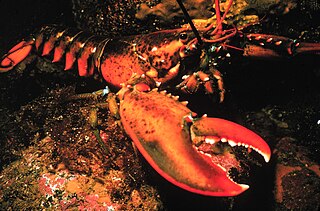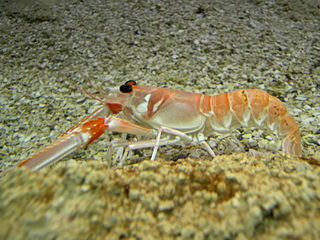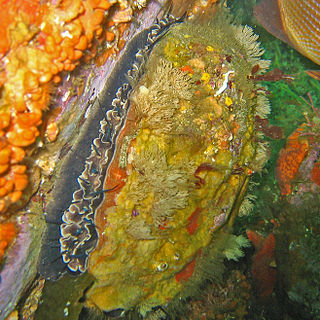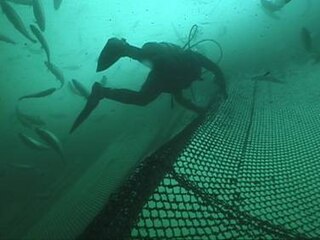Related Research Articles

Lobsters are malacostracans of the family Nephropidae. They have long bodies with muscular tails and live in crevices or burrows on the sea floor. Three of their five pairs of legs have claws, including the first pair, which are usually much larger than the others. Highly prized as seafood, lobsters are economically important and are often one of the most profitable commodities in the coastal areas they populate.

The American lobster is a species of lobster found on the Atlantic coast of North America, chiefly from Labrador to New Jersey. It is also known as Atlantic lobster, Canadian lobster, true lobster, northern lobster, Canadian Reds, or Maine lobster. It can reach a body length of 64 cm (25 in), and a mass of over 20 kilograms (44 lb), making it not only the heaviest crustacean in the world, but also the heaviest of all living arthropod species. Its closest relative is the European lobster Homarus gammarus, which can be distinguished by its coloration and the lack of spines on the underside of the rostrum. American lobsters are usually bluish green to brown with red spines, but several color variations have been observed.

Homarus is a genus of lobsters, which include the common and commercially significant species Homarus americanus and Homarus gammarus. The Cape lobster, which was formerly in this genus as H. capensis, was moved in 1995 to the new genus Homarinus.

Homarus gammarus, known as the European lobster or common lobster, is a species of clawed lobster from the eastern Atlantic Ocean, Mediterranean Sea and parts of the Black Sea. It is closely related to the American lobster, H. americanus. It may grow to a length of 60 cm (24 in) and a mass of 6 kilograms (13 lb), and bears a conspicuous pair of claws. In life, the lobsters are blue, only becoming "lobster red" on cooking. Mating occurs in the summer, producing eggs which are carried by the females for up to a year before hatching into planktonic larvae. Homarus gammarus is a highly esteemed food, and is widely caught using lobster pots, mostly around the British Isles.

The Gulf of Maine is a large gulf of the Atlantic Ocean on the east coast of North America. It is bounded by Cape Cod at the eastern tip of Massachusetts in the southwest and by Cape Sable Island at the southern tip of Nova Scotia in the northeast. The gulf includes the entire coastlines of the U.S. states of New Hampshire and Maine, as well as Massachusetts north of Cape Cod, and the southern and western coastlines of the Canadian provinces of New Brunswick and Nova Scotia, respectively.

Necator americanus is a species of hookworm commonly known as the New World hookworm. Like other hookworms, it is a member of the phylum Nematoda. It is an obligatory parasitic nematode that lives in the small intestine of human hosts. Necatoriasis—a type of helminthiasis—is the term for the condition of being host to an infestation of a species of Necator. Since N. americanus and Ancylostoma duodenale are the two species of hookworms that most commonly infest humans, they are usually dealt with under the collective heading of "hookworm infection". They differ most obviously in geographical distribution, structure of mouthparts, and relative size.

Lobsters are widely fished around the world for their meat. They are often hard to catch in large numbers, but their large size can make them a profitable catch. Although the majority of the targeted species are tropical, the majority of the global catch is in temperate waters.

Nephrops norvegicus, known variously as the Norway lobster, Dublin Bay prawn, shlobster (shrimp-lobster), langoustine or scampi, is a slim, coral colored lobster that grows up to 25 cm (10 in) long, and is "the most important commercial crustacean in Europe". It is now the only extant species in the genus Nephrops, after several other species were moved to the closely related genus Metanephrops. It lives in the north-eastern Atlantic Ocean, and parts of the Mediterranean Sea, but is absent from the Baltic Sea and Black Sea. Adults emerge from their burrows at night to feed on worms and fish.
Perkinsus marinus is a species of alveolate belonging to the phylum Perkinsozoa. It is similar to a dinoflagellate. It is known as a prevalent pathogen of oysters, causing massive mortality in oyster populations. The disease it causes is known as dermo or perkinsosis, and is characterized by the degradation of oyster tissues. The genome of this species has been sequenced.

The Cape lobster, Homarinus capensis, is a species of small lobster that lives off the coast of South Africa, from Dassen Island to Haga Haga. Only a few dozen specimens are known, mostly regurgitated by reef-dwelling fish. It lives in rocky reefs, and is thought to lay large eggs that have a short larval phase, or that hatch directly as a juvenile. The species grows to a total length of 10 cm (3.9 in), and resembles a small European or American lobster; it was previously included in the same genus, Homarus, although it is not very closely related to those species, and is now considered to form a separate, monotypic genus – Homarinus. Its closest relatives are the genera Thymops and Thymopides.
White spot syndrome (WSS) is a viral infection of penaeid shrimp. The disease is highly lethal and contagious, killing shrimp quickly. Outbreaks of this disease have wiped out the entire populations of many shrimp farms within a few days, in places throughout the world.
Taura syndrome (TS) is one of the more devastating diseases affecting the shrimp farming industry worldwide. It was first described in Ecuador during the summer of 1992. In March 1993, it returned as a major epidemic and was the object of extensive media coverage. Retrospective studies have suggested a case of Taura syndrome might have occurred on a shrimp farm in Colombia as early as 1990 and the virus was already present in Ecuador in mid-1991. Between 1992 and 1997, the disease spread to all major regions of the Americas where whiteleg shrimp is cultured. The economic impact of TS in the Americas during that period might have exceeded US$2 billion by some estimates.

Broughton Archipelago Provincial Park is the largest marine provincial park located in British Columbia, Canada. The park is located in the Queen Charlotte Strait around 30 km east of Port McNeill, a town situated on Vancouver Island. In terms of its functions, the park offers tourism opportunities such as kayaking and whale watching, preserves a wide array of wildlife including many at-risk species, and has a long history of use by First Nation peoples.

Haliotis rufescens is a species of very large edible sea snail in the family Haliotidae, the abalones, ormers (British) or pāua. It is distributed from British Columbia, Canada, to Baja California, Mexico. It is most common in the southern half of its range.

Like humans and other animals, fish suffer from diseases and parasites. Fish defences against disease are specific and non-specific. Non-specific defences include skin and scales, as well as the mucus layer secreted by the epidermis that traps microorganisms and inhibits their growth. If pathogens breach these defences, fish can develop inflammatory responses that increase the flow of blood to infected areas and deliver white blood cells that attempt to destroy the pathogens.
Hematodinium is a genus of dinoflagellates. Species in this genus, such as Hematodinium perezi, the type species, are internal parasites of the hemolymph of crustaceans such as the Atlantic blue crab and Norway lobster. Species in the genus are economically damaging to commercial crab fisheries, including causing bitter crab disease in the large Tanner or snow crab fisheries of the Bering Sea.

Panulirus homarus is a species of spiny lobster that lives along the coasts of the Indian and Pacific Oceans. It lives in shallow water, and feeds on the brown mussel Perna perna. It typically grows to a length of 20–25 cm (7.9–9.8 in). Alongside the dark green nominate subspecies, two red subspecies are recognised, one around the Arabian Peninsula, and one around southern Africa. It is the subject of small-scale fishery.

Copper alloys are important netting materials in aquaculture. Various other materials including nylon, polyester, polypropylene, polyethylene, plastic-coated welded wire, rubber, patented twine products, and galvanized steel are also used for netting in aquaculture fish enclosures around the world. All of these materials are selected for a variety of reasons, including design feasibility, material strength, cost, and corrosion resistance.
Gaffkaemia is a bacterial disease of lobsters, caused by the Gram-positive lactic acid bacterium Aerococcus viridans var. homari.

Climate change in the United States Virgin Islands encompasses the effects of climate change, attributed to man-made increases in atmospheric carbon dioxide, in the U.S. territory of the United States Virgin Islands. The United States Environmental Protection Agency (EPA) has noted a variety of expected consequences of this phenomenon.
References
- 1 2 3 Nash, Charlotte; Miller, Miranda; Goffinet, Claire; Godfrey, Caroline; Dunn, Jesse; Cipparone, Hugh; Bulmer, Zakir; Anderson, David J.; Starr, Clay (2018). "A First Report of Shell Disease Impacting Cancer borealis (Jonah Crab) in the Bay of Fundy". Northeastern Naturalist. 25 (4): N27–N31. doi:10.1656/045.025.0411. ISSN 1092-6194. S2CID 92291771.
- ↑ Scavia, Donald; Field, John; Boesch, Donald; Buddemeier, Robert; Burkett, Virginia; Cayan, Daniel; Fogarty, Michael; Harwell, Mark; Howarth, Robert (2002-04-01). "Climate Change Impacts on U.S. Coastal and Marine Ecosystems". Publications, Agencies and Staff of the U.S. Department of Commerce.
- ↑ Reardon, Kathleen M.; Wilson, Carl J.; Gillevet, Patrick M.; Sikaroodi, Masoumeh; Shields, Jeffrey D. (2018). "Increasing prevalence of epizootic shell disease in American lobster from the nearshore Gulf of Maine". Bulletin of Marine Science. 94 (3): 903–921. doi:10.5343/bms.2017.1144. S2CID 90666590.
- ↑ "Blog | Ocean Adapt". oceanadapt.rutgers.edu. Retrieved 2019-04-11.
- ↑ Hoenig, John M.; Groner, Maya L.; Smith, Matthew W.; Vogelbein, Wolfgang K.; Taylor, David M.; Landers, Donald F.; Swenarton, John T.; Gauthier, David T.; Sadler, Philip (2017). "Impact of disease on the survival of three commercially fished species". Ecological Applications. 27 (7): 2116–2127. Bibcode:2017EcoAp..27.2116H. doi: 10.1002/eap.1595 . ISSN 1939-5582. PMID 28675580.
- ↑ Rheuban, Jennie E.; Kavanaugh, Maria T.; Doney, Scott C. (2017). "Implications of Future Northwest Atlantic Bottom Temperatures on the American Lobster (Homarus americanus) Fishery" (PDF). Journal of Geophysical Research: Oceans. 122 (12): 9387–9398. Bibcode:2017JGRC..122.9387R. doi: 10.1002/2017JC012949 . hdl:1912/9535. ISSN 2169-9291.
- ↑ Barris, Brittnee N.; Shields, Jeffrey D.; Small, Hamish J.; Huchin-Mian, Juan Pablo; O'Leary, Patricia; Shawver, Josephine V.; Glenn, Robert P.; Pugh, Tracy L. (2018). "Laboratory studies on the effect of temperature on epizootic shell disease in the American lobster, Homarus americanus". Bulletin of Marine Science. 94 (3): 887–902. doi:10.5343/bms.2017.1148. S2CID 90806119.
- ↑ McLean, EL; Katenka, NV; Seibel, BA (2018-05-28). "Decreased growth and increased shell disease in early benthic phase Homarus americanus in response to elevated CO2". Marine Ecology Progress Series. 596: 113–126. Bibcode:2018MEPS..596..113M. doi:10.3354/meps12586. ISSN 0171-8630. S2CID 90696369.